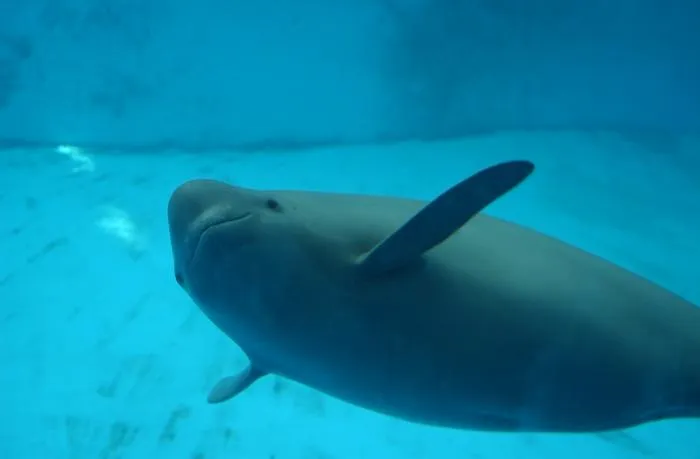WWW.SMITHSONIANMAG.COM
Ancient Chinese Poems Reveal the Decline of a Critically Endangered Porpoise Over 1,400 Years
Art Meets Science
Ancient Chinese Poems Reveal the Decline of a Critically Endangered Porpoise Over 1,400 Years
Researchers looked at poetry dating as far back as the Tang dynasty to find that the Yangtze finless porpoise’s range has decreased by 65 percent
A Yangtze finless porpoise appears to "smile" at the Baiji Dolphinarium at the Chinese Academy of Sciences.
Wang Chaoqun
Over the last 1,400 years, populations of the Yangtze finless porpoise have dramatically declined in China. But intensive surveys of its range only span the last couple of decades, leaving lots of gaps in scientists’ knowledge of the species. In a creative blend of art and science, a new study uses historical poetry to chart the critically endangered animal’s population across the river it calls home.
The finless porpoises once lived throughout the entire Yangtze River, which stretches from the Tibetan Plateau to the East China Sea. Now, the only known freshwater porpoise in the world has fewer than 1,800 individuals left in the wild.
The research team combed through databases of Chinese poetry to find references to the porpoise and map its past distribution. They found 724 poems that mentioned the animal, of which half noted where the porpoises were observed. Their findings were published in the journal Current Biology
“Having access to past data allows us to detect when declines began and correlate those changes with potential threats like habitat destruction, climate change, overhunting, disease or the introduction of invasive species,” says study lead author Yaoyao Zhang, an ecologist at the Chinese Academy of Sciences, to Gennaro Tomma at Scientific American.
The poems suggest the porpoise’s range has decreased by 65 percent since the Tang dynasty (618–907 C.E.). Most of that decline happened in the river’s tributaries and lakes, where the animal’s range has decreased by 91 percent.
A Ming dynasty woodblock-printed illustration from "Sancai Tuhui" (Compendium of the Three Powers), a 49-volume book of poems about animals. This poem describes the Yangtze finless porpoise with morphological details, surfacing postures and maternal care behaviors.
"Sancai Tuhui," compiled by Wang Qi (1573–1620)
While the population decrease was mostly gradual, the sharpest decline occurred over the past 100 years. That sudden drop aligns with human activities on the river, especially dam construction in the 1950s that blocked off the porpoise’s movement to and from the river’s main channel.
The work highlights the connection between culture and science. “Poems are actually ancient citizen science,” says study co-author Jiajia Liu, an ecologist at Fudan University in China, to McKenzie Prillaman at Science News. “These data are not perfect. … But they do have a lot of information if you use them correctly.”
Many Chinese poets were “well-educated intellectuals,” according to the paper, and often described animals in an accurate way. And because these poets often held official positions in society, their whereabouts were often documented, per Science News.
This methodology has potential for uncovering the pasts of other endangered species as well. The study “builds on many prior examples on how historical texts of various kinds can help understand past species distributions and, not least, human-caused biodiversity losses,” says Jens-Christian Svenning, a macroecologist at Aarhus University in Denmark who was not involved in the work, to Scientific American. Previously, scholars have used medieval and ancient texts to understand things like volcanic eruptions, auroras and unusual whales.Zhigang Mei, a hydrobiologist at the Chinese Academy of Sciences and a study co-author, echoes those sentiments in a statement, saying the work made him rethink the scientific value of historic literature, in particular. “Chinese poetry, this ancient art form, can be a serious scientific tool,” he says. “Using the past to understand the present, ‘decoding’ the stories behind the art: It’s not just research, it’s like having a conversation with the poets of the past.”
Next, the team will use poems in an attempt to determine how the Yangtze River once looked, how the ancient porpoises might have behaved at the height of their population and how big their groups once were, Zhang tells Scientific American.
The researchers hope their new work inspires more scientists to look toward poetry and other art forms as part of their studies.
“Protecting nature isn’t just the responsibility of modern science; it’s also deeply connected to our culture and history,” says Mei in the statement. “Art, like poetry, can really spark an emotional connection, making people realize the harmony and respect we should have between people and nature.”
Get the latest stories in your inbox every weekday.
